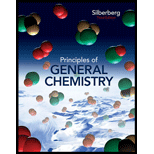
(a)
Interpretation:
The number of particles present in the air for the given space is to be determined.
Concept Introduction:
The air in the atmosphere is a mixture of different gases and particles. Usually, air contains a balanced composition of gases and particles. However, emissions from industries and automobiles can increase the amount of some gases and particles in air. It causes an imbalance of the atmosphere which can lead to some harmful outcomes.
(a)
Answer to Problem 1.76P
The number of particles present in the air for the given space is
Explanation of Solution
Assuming the particles in air are spherical structures with a dimeter of
Where,
Thereafter, the total volume of the room has to be calculated. The dimensions of the room are given in the units of feet, thus, the units should be converted into meters.
The equation can be used to determine the number of particles in the room.
Therefore, first, the mass of a particles should be calculated.
Then the obtained values can be used in the above mentioned equation to get the number of particles in the room.
(b)
Interpretation:
The amount of particles in air per breath a human takes is to be calculated.
Concept Introduction:
The air in the atmosphere is a mixture of different gases and particles. Usually, air contains a balanced composition of gases and particles. However, emissions from industries and automobiles can increase the amount of some gases and particles in air. It causes an imbalance of the atmosphere which can lead to some harmful outcomes.
(b)
Answer to Problem 1.76P
The allowable amount of particles in air per breath a human takes is
Explanation of Solution
Assuming the particles in air are spherical structures with a dimeter of
Where,
Mass of a particle can be calculated using this volume.
The allowable amount of particles in the human breath can be calculated as follows:
Want to see more full solutions like this?
Chapter 1 Solutions
Principles of General Chemistry
- What would you expect to be the major product obtained from the following reaction? Please explain what is happening here. Provide a detailed explanation and a drawing showing how the reaction occurs. The correct answer to this question is V.arrow_forwardPlease answer the question for the reactions, thank youarrow_forwardWhat is the product of the following reaction? Please include a detailed explanation of what is happening in this question. Include a drawing showing how the reagent is reacting with the catalyst to produce the correct product. The correct answer is IV.arrow_forward
- Please complete the reactions, thank youarrow_forwardConsider the synthesis. What is compound Y? Please explain what is happening in this question. Provide a detailed explanation and a drawing to show how the compound Y creates the product. The correct answer is D.arrow_forwardWhat would be the major product of the following reaction? Please include a detailed explanation of what is happening in this question. Include steps and a drawing to show this reaction proceeds and how the final product is formed. The correct answer is B. I put answer D and I don't really understand what is going on in the question.arrow_forward
- What is the product of the following reaction? Please explain what is happening in this question. Provide a detailed explanation and a drawing showing how the reagent is reacting with the catalysts to product the correct product. The correct answer is B.arrow_forwardWhat is the missing intermediate 1 and the final product 2. Please include a detailed explanation explaining the steps of malonic ester synthesis. Please include drawings of the intermediate and how it occurs and how the final product is former.arrow_forwardWhat would be the reagents and conditions above and below the arrow that will complete the proposed acetoacetic ester synthesis? If it cannot be done efficiently, then I will choose that answer. There could be 2 or 4 reagents involved. Please provide a detailed explanation and drawings showing how it would proceed with the correct reagents.arrow_forward
- For benzene, the ∆H° of vaporization is 30.72 kJ/mol and the ∆S° of vaporization is 86.97 J/mol・K. At 1.00 atm and 228.0 K, what is the ∆G° of vaporization for benzene, in kJ/mol?arrow_forwardThe reaction Q(g) + R(g) → Z(l) is shown to be exothermic. Which of the following is true concerning the reaction. it is spontaneous only at High T, it is spontaneous at low T it is nonspontaneous at all T it is spontanrous at all T. it is non spontaneous only at low T.arrow_forwardThe reaction Q(g) + R(g) → Z(l) is shown to be exothermic. Which of the following is true concerning the reactionarrow_forward
 Chemistry: The Molecular ScienceChemistryISBN:9781285199047Author:John W. Moore, Conrad L. StanitskiPublisher:Cengage Learning
Chemistry: The Molecular ScienceChemistryISBN:9781285199047Author:John W. Moore, Conrad L. StanitskiPublisher:Cengage Learning Chemistry for Engineering StudentsChemistryISBN:9781337398909Author:Lawrence S. Brown, Tom HolmePublisher:Cengage Learning
Chemistry for Engineering StudentsChemistryISBN:9781337398909Author:Lawrence S. Brown, Tom HolmePublisher:Cengage Learning

